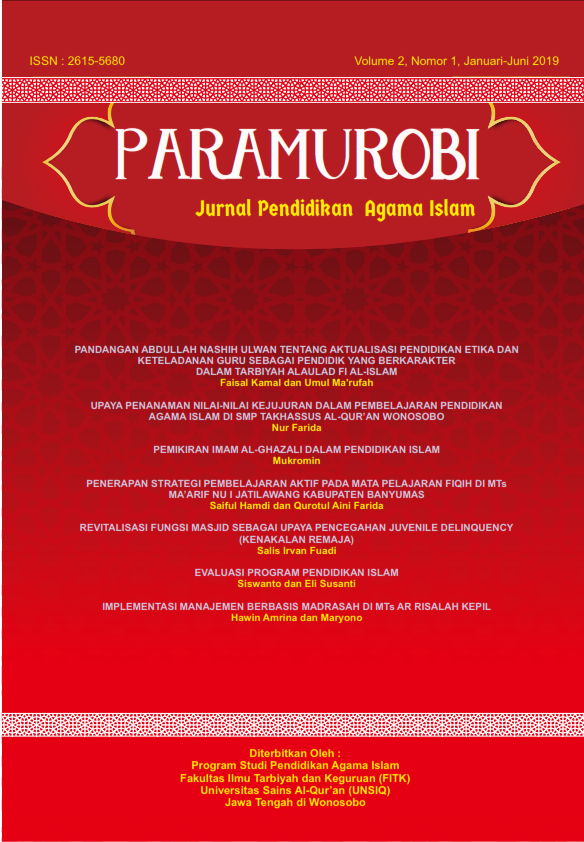REVITALISASI FUNGSI MASJID SEBAGAI UPAYA PENCEGAHAN JUVENILE DELINQUENCY (KENAKALAN REMAJA)
DOI:
https://doi.org/10.32699/paramurobi.v2i1.816Kata Kunci:
Revitalisasi, Juvenile Delinquency, Mosque,Abstrak
The mosque at this time its function has somewhat faded, it looks much different when the
mosque functioned as the center of the activities of the people in the time of Rasulluah SAW.
Nowadays the mosque's function is only used in activities that are merely like a prayer.
People, especially teenagers, rarely maximize mosques for non-religious activities. This
is for teenagers will cause a sense of shame on the mosque and more worrying about the
less controlled youth activities. Juvenile delinquency is very prevalent in the community.
Revitalization of mosque functions as an effort to prevent Juvenile Deliqeuecy (Juvenile
Delinquency) is necessary. The revitalization of the function of the mosque as an effort
to prevent Juvenile Deliquency (Youth Delinquency) covers the field of organization,
worship, education, social and economic. In the field of organization is to maximize the
role of adolescent mosque bonds, in the field of worship is the program "shame without
berjama'ah", then in the field of education is "mosque science warehouse", and "mosque
solution msyarakat" revitalisasi social field and the last field of economy that is " economic
teen-based mosque ".
Referensi
Ahmad, F Adam, Z Mohamad. 2012.
“Religious Education Programs In The
Rural Mosques, Terengganu, Malaysia”.
British Journal of Humanities and Social
Sciences. November 2011, Vol. 2 (2).
Amin, Samsul Munir. 2009. Sejarah Peradaban
Islam. Jakarta: Amzah
Arief, Armai. 2014. Sejarah Pertumbuhan dan
Perkembangan Lembaga- Lembaga
Pendidikan Islam Klasik. Bandung:
Angkasa.
Astari, Puji. 2014. “Mengembalikan Fungsi
Masjid Sebagai Pusat Peradaban
Masyarakat”. Jurnal Ilmu dakwah dan
Pengembangan Komunitas. VOL. 9
No.1 Januari 2014.
Dewan Redaksi Ensiklopedi Islam. 1994.
Ensiklopedi Islam, Cet. Ke 2, PT. Jakarta:
Ichtiar Baru Van Houve.
Fahmi, Asma Hasan. 1997. Sejarah dan
Pendidikan Islam. Jakarta: Bulan
Bintang.
Farahati, Abbasali. 2011. “The Mosque as the
First Political-Ideological Base in the
Islamic Society”. Journal of Politics and
Law Vol. 4, No. 1; March.
Fathurrahman. 2015. “Masjid Sebagai Pusat
Pendidikan Islam Masa Klasik”. Jurnal
Studi Pemikiran Pendidikan Agama
Islam Kreatif, Vol. XII No. 1 Januari
2015.
Hasarudin. 2011. “Madrasah pada Masa Islam
Klasik: Analisis Historis atas Metode
yang Digunakan,” Hunafa: Jurnal Studia
Islamika vol. 8, No. 1 Juni 2011.
Maqdisi, George. 1981. The Rise of Colleges:
Institution of Learning in Islam and the
West, (Edinburgh: Edinburgh UniversityPress: 1981), 21.
Mohd Sanusi, Zuraidah, dkk, The Effects of
Internal Control System, Financial
Management and Accountability of
NPOs: The Perspective of Mosques
in Malaysia, Malaisya: Jurnal
Internasional, 2015.
Mulyono, Rekonstruksi Peran dan Fungsi M U A
D D I B Vol.07 No.01 Januari-Juli 2017.
Muslim, Aziz. 2004. “Manajemen Pengelolaan
Masjid.” Jurnal Aplikasi llmu-ilmu
Agama, Vol. V, No. 2, Desember.
Hlm.105-114.
Pertiwi, Ruspita Rani. 2008. “Manajemen
Dakwah berbasis Masjid”, Jurnal MD
Vol I No. 1 Juli-Desember.
Zaimeche, Saleh. 2002. Education in Islam The
Role of the Mosque. United Kingdong:
Foundation for Science Technologi and
Civilation.
Zulkiple & Jazeel. 2013. “History, Distribution
and Affiliation of Mosque in Muslim
Minority of Sri Lanka”. International
Journal of Humanities and Social
Science Vol. 3 No. 1
Unduhan
Diterbitkan
Terbitan
Bagian
Lisensi
Pemberitahuan Hak Cipta
1. Penulis memiliki hak cipta dan memberikan jurnal hak publikasi pertama dengan karya yang secara simultan dilisensikan di bawah Lisensi Atribusi Creative Commons (CC BY-SA 4.0) yang memungkinkan orang lain untuk berbagi (menyalin dan mendistribusikan kembali materi dalam media atau format apa pun), dan menyesuaikan (mencampur, mengubah, dan membangun di atas bahan) karya untuk tujuan apa pun, bahkan secara komersial dengan pengakuan kepengarangan karya dan publikasi awal dalam jurnal ini.
2. Penulis dapat masuk ke dalam pengaturan kontrak tambahan yang terpisah untuk distribusi non-eksklusif versi jurnal yang diterbitkan dari karya tersebut (misalnya, mempostingnya ke repositori institusional atau menerbitkannya dalam sebuah buku), dengan pengakuan awal publikasi dalam jurnal ini.
3. Penulis diizinkan dan didorong untuk memposting pekerjaan mereka secara online (misalnya, dalam repositori institusional atau di situs web mereka) sebelum dan selama proses pengajuan, karena dapat menyebabkan pertukaran yang produktif, serta kutipan yang lebih awal dan lebih besar dari karya yang diterbitkan ( Lihat Pengaruh Akses Terbuka).





